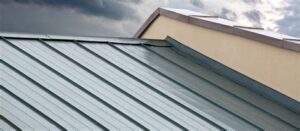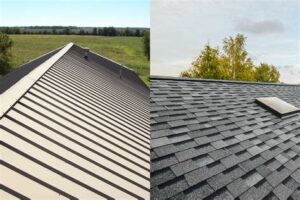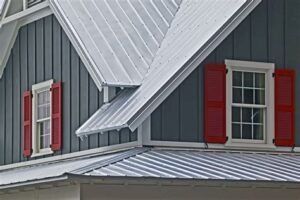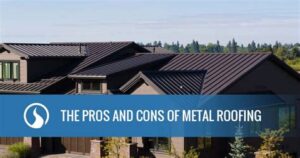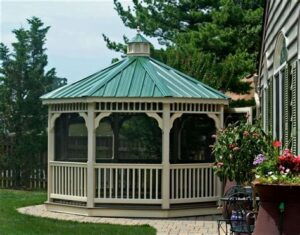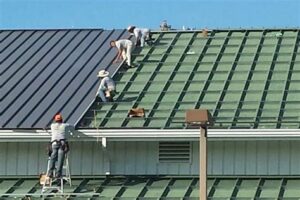Are you considering upgrading your home’s roofing system? Look no further than copper metal roof materials—an option that not only enhances your property’s aesthetic appeal but also offers remarkable durability and longevity. This comprehensive buying guide will take you through everything you need to know about copper roofing, from understanding its myriad benefits to essential factors to consider for your purchase. We’ll delve into maintenance tips to keep your roof looking pristine, provide a detailed cost analysis to help you understand the investment, and offer expert advice on effective installation techniques. Whether you’re a homeowner seeking lasting quality or a contractor looking to expand your material knowledge, this guide is designed to equip you with the insights needed to make an informed choice about copper metal roofs. Let’s transform your roofing project into a success!
Understanding The Benefits Of Copper Metal Roof Materials
When it comes to roofing materials, copper offers a range of benefits that make it a superior choice for homeowners and builders alike. Below are some of the key advantages of using copper metal roof materials:
- Longevity: Copper roofs can last over 100 years, significantly outpacing other roofing materials. Their longevity means fewer replacements, ultimately saving you money in the long run.
- Aesthetic Appeal: With its unique, natural patina that develops over time, a copper roof adds a distinct character and elegance to any home, making it a popular choice among designers.
- Low Maintenance: Copper roofs require minimal maintenance compared to traditional roofing materials. They resist corrosion and are less prone to leaks, reducing the need for regular inspections and repairs.
- Eco-Friendly: Copper is a recyclable material, making it an environmentally friendly choice. Its long lifespan also contributes to reduced waste in landfills.
- Energy Efficiency: Copper roofs reflect sunlight, helping to keep your home cooler in summer and potentially lowering energy costs.
- Fire Resistance: Copper is non-combustible and can withstand extreme temperatures, providing an added layer of protection for your home against fire hazards.
Incorporating copper roofing into your home renovation or construction project not only enhances the visual appeal but also ensures a durable, sustainable, and low-maintenance roofing solution that stands the test of time. The Ultimate choice for those looking for a combination of beauty and functionality is undoubtedly copper metal roof materials.
Essential Factors To Consider When Choosing Copper Roofing
When selecting the ultimate copper roofing material for your project, there are several critical factors to consider that can influence both the performance and aesthetics of your roof. Below are the key elements you should evaluate:
| Factor | Considerations |
|---|---|
| Gauge | Thicker gauges provide better durability and longevity. Common gauges include 16, 18, and 20. The lower the gauge number, the thicker the material. |
| Finish | Consider whether you want the natural patina that develops over time or a pre-treated finish for a specific aesthetic. Pre-treated options can enhance oxidation resistance. |
| Style & Design | Choose a copper roofing style that complements your home’s architecture, such as standing seam, shingles, or tiles. |
| Manufacturer Reputation | Select a reliable manufacturer known for high-quality copper products to ensure material performance and warranty options. |
| Installation Requirements | Consider the complexity of the installation process, including whether you will need professional help or if it’s manageable as a DIY project. |
| Environmental Impact | Evaluate the sustainability of the copper production and recycling processes, as well as its energy efficiency in roofing applications. |
By closely examining these factors, you’re on your way to making a well-informed decision and securing the ultimate copper roofing solution that enhances your home’s value and aesthetic appeal.
The Ultimate Maintenance Tips For Copper Roofs
Maintaining a copper roof is crucial to ensure its longevity and aesthetic appeal. Here are some The Ultimate maintenance tips that will help you keep your copper roofing in top condition:
- Regular Inspections: Conduct inspections at least twice a year, preferably in spring and fall. Look for signs of corrosion, leaks, or any debris accumulation that could hinder water drainage.
- Cleaning: Clean your copper roof to remove leaves, dirt, and moss. Use a soft-bristle brush and a mixture of mild detergent and water. Avoid harsh chemicals that can damage the copper finish.
- Corrosion Treatment: If you notice any corrosion, treat it immediately. Use a copper cleaner specifically designed for this material and follow the manufacturer’s instructions.
- Sealants: While copious amounts of sealants are generally unnecessary, a light application can help protect areas that are prone to rust, such as joints and fasteners.
- Gutter Maintenance: Ensure that gutters are free from blockages. Clean them regularly to prevent water buildup, which can cause damage to the roof and underlying structures.
- Consult a Professional: If you notice significant issues or if your roof requires repairs, consult with a licensed roofing contractor familiar with copper roofs to ensure the best practices are followed.
By following these The Ultimate maintenance tips, you can enjoy the beauty and durability of your copper roof for many years to come. Regular upkeep not only enhances the appearance of your home but also ensures that your investment remains protected.
Cost Analysis: Investing In Copper Metal Roof Materials
When considering a roofing solution, evaluating the cost of The Ultimate copper metal roof materials is essential for making an informed decision. The initial investment in copper roofing can be higher than that of conventional materials like asphalt shingles or steel roofing. However, understanding the long-term value it offers is crucial.
The price of copper roofing can range significantly based on factors such as thickness, finish, and the complexity of the installation. On average, homeowners can expect to pay between $15 to $30 per square foot for materials alone, which is noticeably higher compared to other roofing options. Despite the upfront costs, it’s important to assess the benefits over time.
Here are some key points to consider for your cost analysis:
- Durability: Copper roofs can last 50 years or more with minimal upkeep, which reduces the frequency of replacement costs.
- Energy Efficiency: Copper reflects heat effectively, leading to lower energy bills during the summer months.
- Aesthetic Appeal: The unique visual appeal of copper, which develops a natural patina over time, can enhance property value and curb appeal.
- Low Maintenance Needs: Unlike other roofing materials, copper usually requires less maintenance, which translates to savings in long-term upkeep.
Moreover, when calculating the total investment, it’s essential to include installation costs. Professional installation is recommended due to the complexity of working with copper. This can add an additional $5 to $10 per square foot, depending on your location and the company hired.
While the initial cost of investing in copper metal roof materials may seem significant, the long-term savings, durability, and unique benefits make it a wise choice—truly embodying The Ultimate in roofing materials. Always consult with a roofing professional to obtain detailed estimates based on your specific project needs, ensuring your investment aligns with your budget and expectations.
How To Install Copper Metal Roofs Effectively
Installing copper metal roofs can be a rewarding yet meticulous process. To achieve the best results, follow these detailed steps:
- Prepare the Roof Deck: Ensure the substrate is clean, dry, and structurally sound. Replace any damaged areas and ensure that the surface is free from debris.
- Install Underlayment: A durable underlayment is essential for moisture protection. Use high-quality synthetic underlayment that is specifically recommended for metal roofing applications.
- Plan the Layout: Before installation, plan the panel layout for optimal aesthetics and functionality. This involves marking guidelines on the roof deck to maintain a straight line.
- Cutting Copper Panels: When cutting copper panels, use a snip cutter to avoid damaging the metal. Make precise measurements and cuts to ensure that each panel fits correctly.
- Install the Panels: Start from the bottom edge of the roof and work your way upwards. Secure the panels in place using screws that are specifically designed for metal roofing. Ensure that the screws are not over-tightened, which can lead to panel warping.
- Creating Overlaps: For waterproofing, ensure that each panel overlaps the previous one by at least 1.5 inches. This step is crucial for preventing moisture penetration.
- Install Flashings: Use copper flashings around chimneys, vents, and roof edges to provide additional protection against leaks. Properly sealing these areas is critical to the long-term performance of your copper roof.
- Finishing Touches: Once the panels are in place, inspect your work for any loose screws or areas where water could potentially enter. Make adjustments as needed.
Following these steps will ensure that your installation is up to standard, maximizing the ultimate benefits of your new copper metal roof. Always consult with a professional if you’re unsure about any part of the process, as proper installation is key to the longevity of your roofing system.
Frequently Asked Questions
What are the main benefits of choosing copper metal roofing?
Copper metal roofing offers long-lasting durability, natural resistance to corrosion and weathering, a unique aesthetic appeal, and low maintenance needs.
How does copper roofing compare in terms of cost to other roofing materials?
While copper roofing tends to have a higher upfront cost compared to materials like asphalt or steel, its longevity and durability can lead to lower overall lifetime costs.
What factors should I consider when choosing copper roofing for my home?
Consider factors like your budget, architectural style, climate, and desired maintenance level. Consulting with a roofing expert can also help ensure the right choice.
Is copper roofing environmentally friendly?
Yes, copper is a sustainable material. It is recyclable, has a long lifespan, and can contribute to energy efficiency when installed properly.
What is the lifespan of copper roofing materials?
Copper roofing can last over 50 years, with many installations lasting well beyond that with proper maintenance.
Does copper roofing require special installation techniques?
Yes, installing copper roofing often requires skilled professionals familiar with the material’s unique properties to ensure proper handling and installation.
What are the color options available for copper roofing, and how do they change over time?
Copper starts with a shiny, reddish-brown color that develops a green patina over time due to oxidation, which many homeowners appreciate for its aesthetic appeal.
